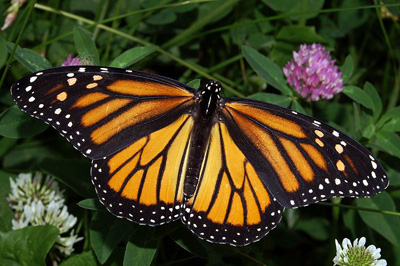
Have you ever been in Toluca, Mexico, to catch a glimpse of the monarch butterfly migration? I was, back in the mid ’90s, to witness one of the most glorious and spectacular mysteries in the world we live in. It may very well be too late for you now, and I’ll tell you why.
Chip Taylor, biology professor at the University of Kansas, reports in his latest study that during this year’s winter, monarch migration was 1/20 of its normal size, or down to 5 percent of its former glory. This may very well be the last year we see those magnificent beings engage in a most mysterious yearly migration that takes several generations to complete and covers up to 6,000 miles round-trip from central Mexico in early spring to Eastern Canada, in two or three generations, and back in the fall to Mexico to overwinter, in one single generation. Neither generation knows whether their parents were going or coming since they are long gone and dead, where they are supposed to be headed to, or where the final destinations are, but they always find the way to the same roosting places and trees, and back again. It is simply astounding!
I also witnessed the rows of slowly moving empty trucks going into the pine forests at dusk, one after another, and heard the ripping chainsaw noise starting shortly thereafter and going all through the night, uninterrupted. I saw the trucks’ slow return, fully loaded with fresh cut pines in the early dawn. The pungent and sweet-smelling scent of the fresh resin permeated the air – announcing their arrival, as if in an ancient ritual of incense and death. The sacrifice of the pines is the loss of the monarchs’ overwintering habitat, where they cluster by the millions to keep warm through the night and during cold spells. I ventured into the forest to talk to the loggers with my Mexican friends, the whole family with the kids in tow, but there was not much to do other than to extend a friendly hello and say “buenas noches.” The loggers were all armed and on the ready.
On the warm and sunny afternoon, as I stood on the blacktop of the narrow single lane country road, monarch butterflies flowed downhill following both sides of the asphalt in single military file. As I put myself directly in the flow, they came straight to my face in their bambolean dance flight. I could see their bodies, fat and plump, as thick as my pinky finger, their energy reserves accumulated for the
approaching winter. At the last moment, they noticed me, one foot or two from my face, and rapidly swung to one side or another to continue undisturbed on their mission.
 (Photo: Wikipedia)On their journey, they feed on pollen and nectar from many flowers and
(Photo: Wikipedia)On their journey, they feed on pollen and nectar from many flowers and
plants, milkweeds being the preferred genus on which they lay their eggs, procreate, and leave their larvae, which feed and later pupate on milkweed. Milkweed sap is poisonous to many species, including humans, and gives the caterpillars a distinctive stripped coloration of yellow and black stripes.
While 1 billion monarchs overwintered on 50 acres during peak migrations of just a few years ago, fewer than 3 acres were occupied by December of 2012, less than half as many as the previous year, a dramatic reduction. At this rate, this may very well be the last year we have the opportunity to witness this awe-inspiring migration.
What can you do? At least four things
1. Start a milkweed garden on your yard no matter how small. On the monarchwatch.org, find the milkweed species that are best adapted to the climate of your space.
2. Stop buying and consuming agricultural products that are grown using synthetic chemicals, and choose certified organic produce only. The reason for this is that organic agriculture bans the use of synthetic pesticides, herbicides and genetically modified organisms (GMOs), which cause untold death and destruction to beneficial pollinators including monarchs and other butterflies. Corn pollen is one of the monarchs’ favorite foods, and at least
two peer-reviewed studies, one by the Russian Academy of Sciences and
the other at Cornell University, indicate a large percentage, up to 44 percent, of the monarchs in the study died when fed exclusively with GMO varieties.
3. Contact your senators and representatives, both state and federal, and demand a ban on the use of all pesticides, herbicides and GMOs, and ask them
to start a well-thought-out plan of protection and conservation of milkweed habitats in the United States, Mexico and Canada, together with effective protection and reforestation of the monarch overwintering pine forests in Mexico.
4. Contact your city officials in parks and recreation and ask them to halt the
use of synthetic pesticides and herbicides and to plant milkweed patches on every park around town and around the county.
Monarchs are important pollinators and perform a valuable service to all humankind and to many other species, a contribution to the web of life on which it is difficult, if not altogether impossible, to put a monetary value, if that is what concerns you.
Second, such a spectacular migration with all its mysteries makes us wonder as to the nature and meaning of it all, life, death and this unfathomable universe all around us.
For that, there is really no value in whatever form – money, gold, diamonds, anything – that is a substitute. None.
48 Hours Left: All gifts to Truthout now matched!
From now until the end of the year, all donations to Truthout will be matched dollar for dollar up to $28,000! Thanks to a generous supporter, your one-time gift today will be matched immediately. As well, your monthly donation will be matched for the whole first year, doubling your impact.
We have just 48 hours left to raise $28,000 and receive the full match.
This matching gift comes at a critical time. As Trump attempts to silence dissenting voices and oppositional nonprofits, reader support is our best defense against the right-wing agenda.
Help Truthout confront Trump’s fascism in 2026, and have your donation matched now!